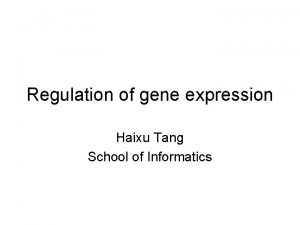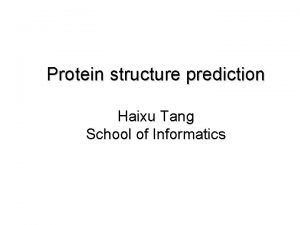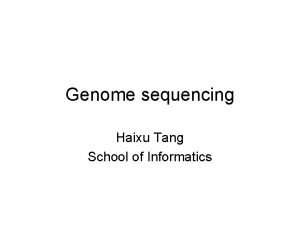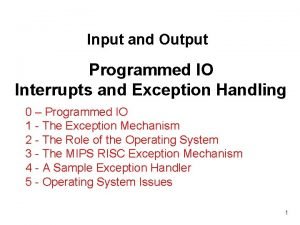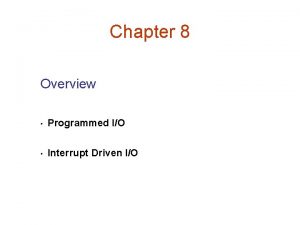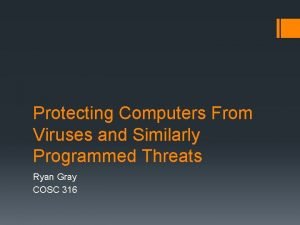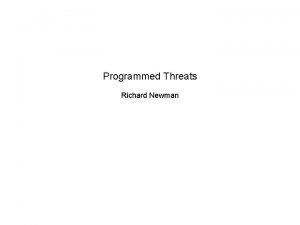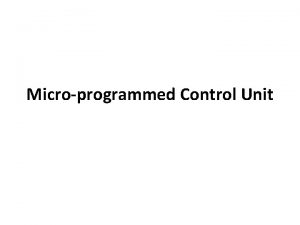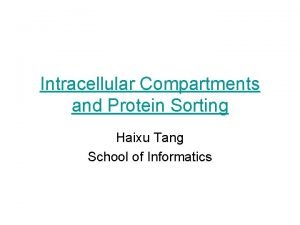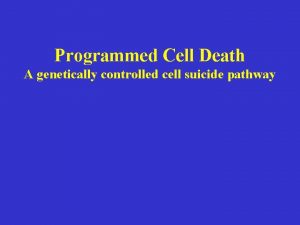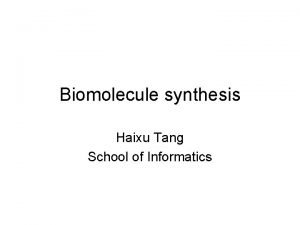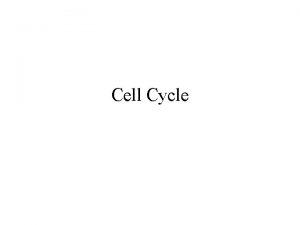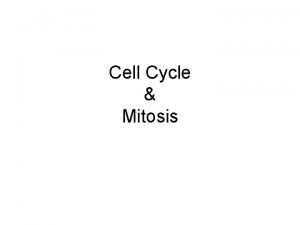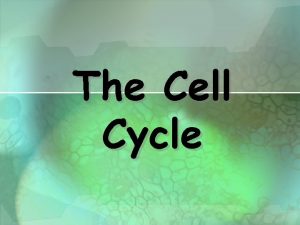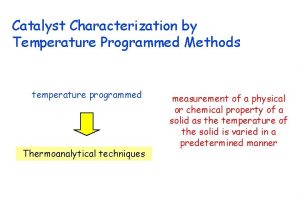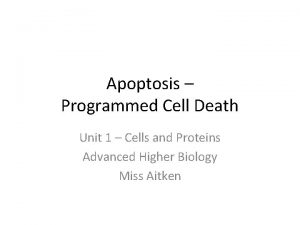Cell cycle and cell programmed death Haixu Tang

































- Slides: 33

Cell cycle and cell programmed death Haixu Tang School of Informatics

The cell cycle

The events of eucaryotic cell division

The phases of the cell cycle

A comparison of the cell cycles of fission yeasts and budding yeasts

The behavior of a temperaturesensitive cdc mutant

The Cell-Cycle Control System Can Be Analyzed Biochemically in Animal Embryos

The Cell-Cycle Control System of Mammals Can Be Studied in Culture

Labeling S-phase cells

FACS: fluorescence-activated cell sorter

The control of the cell cycle

Basic control system • A clock, or timer, that turns on each event at a specific time, thus providing a fixed amount of time for the completion of each event. • A mechanism for initiating events in the correct order; entry into mitosis, for example, must always come after DNA replication. • A mechanism to ensure that each event is triggered only once per cycle. • Binary (on/off) switches that trigger events in a complete, irreversible fashion. It would clearly be disastrous, for example, if events like chromosome condensation or nuclear envelope breakdown were initiated but not completed. • Robustness: backup mechanisms to ensure that the cycle can work properly even when parts of the system malfunction. • Adaptability, so that the system's behavior can be modified to suit specific cell types or environmental conditions.

The Control System Can Arrest the Cell Cycle at Specific Checkpoints

Checkpoints Generally Operate Through Negative Intracellular Signals • The Cell-Cycle Control System Is Based on Cyclically Activated Protein Kinases • Cdk Activity Can Be Suppressed Both by Inhibitory Phosphorylation and by Inhibitory Proteins • The Cell-Cycle Control System Depends on Cyclical Proteolysis • Cell-Cycle Control Also Depends on Transcriptional Regulation

Two key components of the cellcycle control system • G 1 /S-cyclins bind Cdks at the end of G 1 and commit the cell to DNA replication. • S-cyclins bind Cdks during S phase and are required for the initiation of DNA replication. • M-cyclins promote the events of mitosis. • G 1 -cyclins, helps promote passage through Start or the restriction point in late G 1.

Core of the cell-cycle control system

The structural basis of Cdk activation

The regulation of Cdk activity

The inhibition of a cyclin-Cdk complex by a CKI

The control of proteolysis

Rereplication block.

The initiation of DNA replication once per cell cycle

The activation of M-Cdk

The triggering of sister-chromatid separation by the APC

The creation of a G 1 phase

The control of G 1 progression

How DNA damage arrests the cell cycle?

An overview of the cell-cycle control system

Cell death

The caspase cascade involved in apoptosis

Intracellular Regulators of the Cell Death Program • The Bcl-2 family • IAP (inhibitor of apoptosis) family

Induction of apoptosis by either extracellular or intracellular stimuli

The extracellular signal molecules • Mitogens, which stimulate cell division, primarily by relieving intracellular negative controls that otherwise block progress through the cell cycle. • Growth factors, which stimulate cell growth (an increase in cell mass) by promoting the synthesis of proteins and other macromolecules and by inhibiting their degradation. • Survival factors, which promote cell survival by suppressing apoptosis
 Tang tang tang song
Tang tang tang song Haixu tang
Haixu tang Haixu tang
Haixu tang Haixu tang
Haixu tang Haixu tang
Haixu tang Haixu tang
Haixu tang Cell cycle and cell division
Cell cycle and cell division Cell cycle and cell division
Cell cycle and cell division Cell cycle phases
Cell cycle phases Somatic and molecular death
Somatic and molecular death Biology.arizona.edu/cell bio/activities/cell cycle/01.html
Biology.arizona.edu/cell bio/activities/cell cycle/01.html Non programmed decision example
Non programmed decision example Example of non programmed decision
Example of non programmed decision Counters in plc
Counters in plc Nanoprogram
Nanoprogram In managing attractions, a programmed decision is
In managing attractions, a programmed decision is Give an example of programmed decision
Give an example of programmed decision ●non-programmed
●non-programmed Non programmed decision example
Non programmed decision example Non programmed decision example
Non programmed decision example What do we call human internally programmed growth?
What do we call human internally programmed growth? Programmed instruction in hrm
Programmed instruction in hrm Programmed i o
Programmed i o Programmed io vs interrupt driven io
Programmed io vs interrupt driven io Physical perceptual and language development
Physical perceptual and language development Infancy and childhood physical development
Infancy and childhood physical development Programmed threats
Programmed threats Programmed threats
Programmed threats Functioning of micro programmed control unit
Functioning of micro programmed control unit Teknik canned sales presentation adalah
Teknik canned sales presentation adalah Programmed i/o in computer architecture
Programmed i/o in computer architecture Pla circuit example
Pla circuit example Binary microprogram
Binary microprogram Programmed instruction
Programmed instruction


